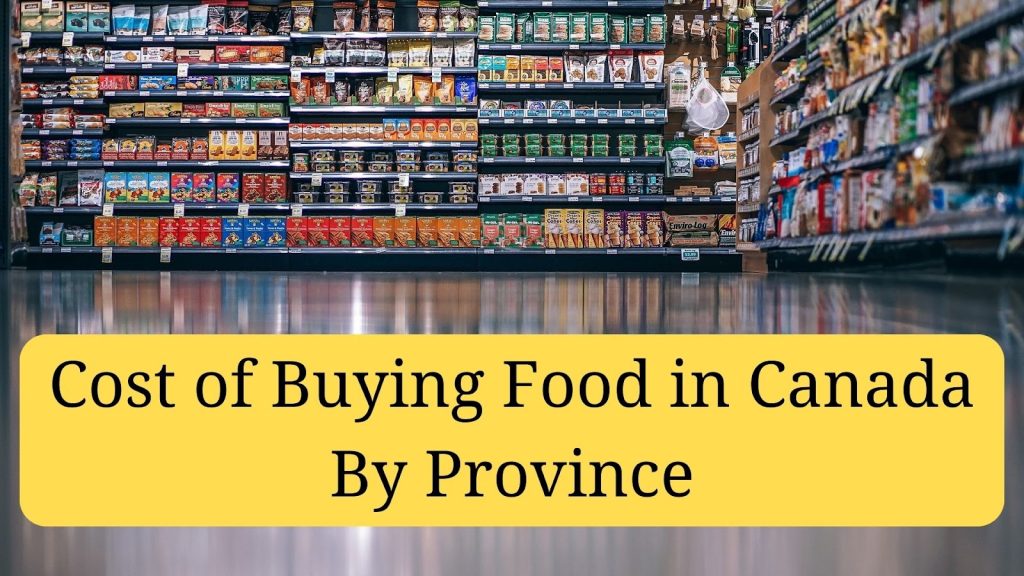Food is an important aspect of human life. It is consumed by every human living on Earth. It plays a major role in the daily lives of Canadians. It impacts the household budgets and the whole quality of life. We know food is a necessity in our lives. But it is important to make sure that it is duly budgeted for. The cost of buying food in Canada varies from region to region.
This cost is influenced by multiple factors. Like the province in which you are buying and the outlet from where you are buying. Also, if you are buying in bulk or lesser quantities. You can make your household budget efficient by understanding these price variations.
In this article, we will discuss the food prices in Canada by province, the factors influencing food prices, and the average spending on groceries in Canada. We will also provide a comparison of grocery costs between Quebec and Ontario.
Food Prices in Canada:
Canada’s Food Price Report forecasts an overall increase of 5% to 7%. According to this report, Canadians will feel the effects of high food inflation in 2024. Also, food affordability will be a concern.
| FOOD CATEGORIES | EXPECTED CHANGES % |
| Bakery | 5% – 7% |
| Dairy | 5% – 7% |
| Fruits | 3% – 5% |
| Meat | 5% – 7% |
| Other | 5% – 7% |
| Restaurants | 4% – 6% |
| Seafood | 4% – 6% |
| Vegetables | 6% – 8% |
| Overall Increase in Food Prices | 5% – 7% |
Cost of Buying Food in Canada By Province:
Food prices in Canada by province does not stay constant. The cost of buying food in Canada depends on your province. Some food items are cheaper in some provinces than others. The availability and accessibility of certain food items also depend on the province.
Here are some average food prices in Canada by province:
| Province | Average Cost of Groceries |
| Alberta | C$206 |
| British Columbia | C$316 |
| Ontario | C$268 |
| Quebec | C$342 |
| Saskatchewan | C$434 |
| Prince Edward Island | C$516 |
| Newfoundland and Labrador | C$489 |
| Manitoba | C$444 |
| New Brunswick | C$465 |
| Nova Scotia | C$463 |
Factors affecting the Cost of buying Food in Canada:
The food prices in Canada by province vary depending on several factors. The factors that influence the cost of buying food in Canada are:
- Taste
- Convenience
- Price
- Location
- Type of Store
- Weight management
- Inflation
- Culture
- Religion
Grocery Shopping in Canada:
Canadians have several options for grocery shopping. They can purchase food from:
- Supermarkets
- Grocery Stores
- Public Markets
- Farmer’s Markets
Note: Ontario and Quebec have the highest numbers of food and beverage stores in Canada.
Top Grocery Stores in Canada:
Some of the best places in Canada for shopping are:
- Metro
- FreshCo
- Lawtons
- Atlantic Cash and Carry
- Atlantic Superstore
- Sobeys
- Foodland
- Buy-Low Foods
- Price Smart Foods
- Loblaw Companies
- Thrifty Food
- Costco
- Safeway
- HMart
- Food City
- M$M Food market
- Farm Boy
- Foodex
- Valufoods
- No Frills
- Canadian Tire
- Food Basics
- Real Canadian Superstore
- Walmart Canada
Note: Walmart Canada is the most dominant grocery store in Canada.
Top Farmer’s Markets in Canada:
Canadians can buy fresh farm produce from farmer’s markets. Some of the popular farmer’s markets are:
- Wellington Farmers’ Market (Ontario)
- Hamilton Farmer’s Market (Ontario)
- Peachtree Road Farmers Market (Alberta)
- Halifax Seaport Market (Halifax)
- Jean-Talon Market (Quebec)
- Le Grande Marché (Quebec)
- Penticton Farmers’ Market (British Columbia)
- Duncan Farmer’s Market (British Columbia)
- Granville Island (Vancouver)
- Crossroads Market (Calgary, AB)
- St. Lawrence Market (Toronto)
Tips for Grocery Shopping in Canada:
Avoid Shopping When Hungry:
If you’re trying to save money, never go to the grocery store hungry. It’s very significant to budget. You can enjoy the food you love while saving some money.
Buy Generic Items:
Substitute the branded items with counterparts. Sometimes there is no difference between branded and local items. If you substitute a small portion of your grocery, you can save a lot.
Give Up Meats:
Meat prices are high. You can give up meat and try to use vegetables instead. Adding vegetables to your diet can improve your health substantially. If you can’t give up meat, buy larger cuts of meat. Buying meat in larger quantities will cost you less money.
Cash Only:
Don’t bring your credit card to the grocery store, pay cash. If you are not carrying your card, you will not get carried away. You will stick to your grocery list and will not buy unnecessary items. Also, you get to know the individual prices of items. It can help you set your budget.
Stick to the List:
Make a shopping list for the week based on what you need. Stick to the list and avoid spontaneous purchases.
Don’t Buy Prepackaged Foods:
Prepackaged items are easy to use. But they are expensive. Instead of buying already diced vegetables, try to do it yourself. It might take some time and effort, but you can save a lot.
Buy Frozen Items:
Frozen items like fruits and vegetables are just as healthy as fresh ones. Frozen items can cost you less than fresh ones. Especially when certain fruits or vegetables are out of season. You can fulfill your cravings while saving money.
Shop at Discount Stores:
Try to shop at the stores that are offering discounts. You can go to wholesale markets to buy in bulk. Buying in bulk will cost you less.
Don’t Waste Meals:
You can repurpose meats and vegetables. If you roasted a chicken for dinner, use the leftovers to make some other dish. Like a casserole or soup. This can save you money and there will be no wastage of food.
Buy from Cheaper Stores:
Here are some of the cheapest grocery stores in Canada:
- Fresh Co
- No Frills
- Food Basics
- Save on Food
- Extra Foods
- Thrifty Food
- Atlantic Superstore
- Coop
- Giant Tiger
- Costco
- Walmart Canada
Frequently Asked Questions:
According to a survey by Statistics Canada, the amount that an average Canadian spends on groceries is about CA$ 300 per month.
According to Canada’s Food Price Report for 2024, Canada’s average grocery bill for a family of four members will be $1,356.79 a month. ($339.19 per person).
The answer isn’t as simple as it seems. Quebec has been known for relatively lower grocery prices than Ontario. But, the current average cost of groceries in Quebec (C$342 per person, per month) is higher than the average in Ontario (C$268 per person, per month).
Final Words:
So, how much does the average Canadian spend on groceries? What is Canada’s average grocery bill? What are average food prices in Canada by province? This article answers all your questions. If you make the right choices, the high prices of food in Canada may not affect you financially. Follow the above-mentioned tips for grocery shopping to save money. Consider the factors that influence the prices of food in Canada and how much you spend on it. Make a suitable budget for your household spending. Food prices in Canada can vary anytime. So, be prepared for the uncertain circumstances.
Maybe you’re interested to read :
- How To Pay 407 Bill in Canada?
- 10 Easy Ways to Get to Canada and Obtain PR
- How to Become a Notary in Ontario, Canada?
Michael C Vang is a passionate blogger. He has been blogging since 2013 on a variety of topics. He is committed to creating informative and engaging content that helps readers learn more about everything.



